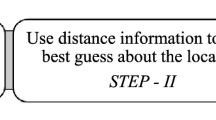Abstract
In location management services, a destination advertises its position attributes to a set of vehicles called location servers while, a source obtains these attributes from such location servers to track destination. The location management techniques in VANET have been categorized into flooding-based, flat hashing-based, hierarchical hashing-based and hierarchical quorum-based techniques. In flooding-based location service, destination information is flooded to the entire network which results into high congestion, low throughput and non-scalable network. In flat hashing, a global hash function is applied to compute location servers of each destination which results into higher delay, drop and signaling overhead in large VANETs. In hierarchical hashing, global hash function computes location servers of destination in hierarchical order. It therefore suffers from handover signaling between servers, high load on the top hierarchy and location query delay when source and destination are apart. In hierarchical quorum-based, location servers are identified cluster-wise and therefore it also suffers from the problems similar to hierarchical techniques. To overcome these problems, ZoomOut Geographic Location Service (ZGLS) protocol is proposed which introduces flat quorum-based location management service. In contrast to the aforementioned techniques, the novelty of ZGLS lies in the fact that it has shifted the location server role from hashing-based or clustering-based geographic areas to few 1-hop neighbours, called relatives. The proposed protocol creates a chain of relatives to provide positioning and tracking service. To evaluate signalling overhead, timeliness and the reliability of update and query packets, ZGLS is compared with RLSMP and HRHLS through ns-2 simulations. The results reveal that ZGLS stands out as a better choice for large-scale sparse and dense VANETs.
















Similar content being viewed by others
Change history
28 August 2018
The original version of this article contained an error in co-author’s affiliation. The correct affiliation of Dr. Waqas Rehan is given in this erratum.
28 August 2018
The original version of this article contained an error in co-author?s affiliation. The correct affiliation of Dr. Waqas Rehan is given in this erratum.
28 August 2018
The original version of this article contained an error in co-author?s affiliation. The correct affiliation of Dr. Waqas Rehan is given in this erratum.
28 August 2018
The original version of this article contained an error in co-author?s affiliation. The correct affiliation of Dr. Waqas Rehan is given in this erratum.
References
Mauve, M., Widmer, J., & Hartenstein, H. (2001). A survey on position-based routing in mobile ad hoc networks. Network, IEEE, 15, 30–39.
Garg, A., Pandey, K., & Singh, B. (2014). Hierarchical map-based location service for VANETs in urban environments. In Contemporary computing (IC3), 2014 Seventh International Conference on, 2014, (pp. 199–205).
Basagni, S., Chlamtac, I., Syrotiuk, V. R., & Woodward, B. A. (1998). A distance routing effect algorithm for mobility (DREAM). In Presented at the proceedings of the 4th annual ACM/IEEE international conference on Mobile computing and networking, Dallas: Texas, USA.
Ko, Y.-B., & Vaidya, N. H. (2000). Location-aided routing (LAR) in mobile ad hoc networks. Wireless Network, 6, 307–321.
Ayaida, M., Fouchal, H., Afilal, L., & Ghamri-Doudane, Y. (2012). A comparison of reactive, grid and hierarchical location-based services for VANETs. In Vehicular technology conference (VTC Fall), IEEE, (pp. 1–5).
Hui, C., Jiannong, C., Hsiao-Hwa, C., & Hongke, Z. (2008). GrLS: group-based location service in mobile ad hoc networks. IEEE Transactions on Vehicular Technology, 57, 3693–3707.
Ashok, D. M., Pai, M. M. M., & Mouzna, J. (2011). Efficient map based location service for VANETs. In 2011 11th international conference on ITS telecommunications (ITST) (pp. 387–392).
Flury, R., & Wattenhofer, R. (2006). MLS: an efficient location service for mobile ad hoc networks. In Presented at the Proceedings of the 7th ACM international symposium on Mobile ad hoc networking and computing, Florence, Italy.
Ayaida, M., Barhoumi, M., Fouchal, H., Ghamri-Doudane, Y., & Afilal, L. (2012). HHLS: A hybrid routing technique for VANETs. In IEEE Global Communications Conference (GLOBECOM) (pp. 44–48).
Euisin, L., Hyunsoo, C., Thirumurthi, P., Gerla, M., & Sang-Ha, K. (2013). Quorum-based location service in vehicular sensor networks. In 9th International wireless communications and mobile computing conference (IWCMC) (pp. 1744–1749).
Zaki, S., Ngadi, M. A., Razak, S., Kamat, M., & Shariff, J. (2012). Location service management protocol for vehicular ad hoc network urban environment. In N. Meghanathan, N. Chaki, & D. Nagamalai (Eds.), Advances in computer science and information technology. Computer Science and Engineering (Vol. 85, pp. 563–574). Berlin: Springer.
Kie, W., Füßler, H., Jorg, W., & Mauve, M. (2004). Hierarchical location service for mobile ad-hoc networks. SIGMOBILE Mobile Computing and Communications Review, 8, 47–58.
Katsaros, K., Dianati, M., & Long, L. (2013). Effective implementation of location services for VANETs in hybrid network infrastructures. In 2013 IEEE international conference on communications workshops (ICC) (pp. 521–525).
Das, S. M., Pucha, H., & Hu, Y. C. (2005). Performance comparison of scalable location services for geographic ad hoc routing. In INFOCOM 2005. 24th annual joint conference of the IEEE computer and communications societies. Proceedings IEEE(vol. 2, pp. 1228–1239).
Boumerdassi, S., & Renault, E. (2016). A flooding-based solution to improve location services in VANETs. In 2016 IEEE international conference on communications (ICC), (pp. 1–6).
Xiang-yu, B., Xin-ming, Y., Jun, L., & Hai, J. (2009). VLS: A map-based vehicle location service for city environments. In IEEE International conference on communications, ICC ‘09 (pp. 1–5).
Ayaida, M., Barhoumi, M., Fouchal, H., Ghamri-Doudane, Y., & Afilal, L. (2014). Joint routing and location-based service in VANETs. Journal of Parallel and Distributed Computing, 74, 2077–2087.
Brahmi, N., Boussedjra, M., Mouzna, J., Cornelio, A. K. V., & Manohara, M. M. (2010). An improved map-based location service for vehicular ad hoc networks. In IEEE 6th international conference on wireless and mobile computing, networking and communications (WiMob) (pp. 21–26).
Boussedjra, M., Mouzna, J., Bangera, P., & Pai, M. M. M. (2009). Map-Based Location Service for VANET, In International conference on ultra modern telecommunications & workshops, 2009. ICUMT ‘09. (pp. 1–6).
Liu, J.-S. L. C.-G. (2013). A Novel Group-based location service management scheme in VANETs. Journal of Advances in Computer Networks, 1, 23–28.
Saleet, H., Basir, O., Langar, R., & Boutaba, R. (2010). Region-based location-service-management protocol for VANETs. Vehicular Technology, IEEE Transactions on, 59, 917–931.
Hyunje, W., & Meejeong, L. (2011). Mobile group based location service management for vehicular ad-hoc networks. In 2011 IEEE international conference on communications (ICC) (pp. 1–6).
Hyunje, W., &. Meejeong, L. (2012). Vehicle location service scheme using the vehicle trajectory for VANETs, In Advanced communication technology (ICACT), 2012 14th international conference on (pp. 1256–1261).
Zaki, S., Ngadi, M. A., & Razak, S. (2014). Location service protocol for highly mobile ad hoc network. Arabian Journal for Science and Engineering, 39, 861–873.
Zeadally, S., Hunt, R., Chen, Y.-S., Irwin, A., & Hassan, A. (2012). Vehicular ad hoc networks (VANETS): status, results, and challenges. Telecommunication Systems, 50, 217–241.
ETSI (2014). Intelligent transport system (ITS); vehicular communications; basic set of applications; Part 2: Specification of cooperative awareness basic service. ed. 650 Route des Lucioles, F-06921 Sophia Antipolis Cedex—FRANCE: European Telecommunications Standards Institute, (p. 44).
Rehan, M., Hasbullah, H., Rehan, W., & Chughtai, O. (2015). ZoomOut HELLO: A novel 1-Hop broadcast scheme to improve network QoS for VANET on highways. In A. Laouiti, A. Qayyum, & M. N. Mohamad Saad (Eds.), Vehicular Ad hoc networks for smart cities (Vol. 306, pp. 75–84). Singapore: Springer.
ISI. Network Simulator 2.33. Available: http://sourceforge.net/projects/nsnam/files/allinone/ns-allinone-2.33/ns-allinone-2.33.tar.gz/download. Accessed 12 Jan 2013.
Harri, J., Filali, F., & Bonnet, C. (2009). Mobility models for vehicular ad hoc networks: A survey and taxonomy. Communications Surveys & Tutorials, IEEE, 11, 19–41.
Sharef, B. T., Alsaqour, R. A., & Ismail, M. (2014). Vehicular communication ad hoc routing protocols: A survey. Journal of Network and Computer Applications, 40, 363–396.
DLR (2013). SUMO—Simulation of Urban Mobility. Available: http://www.dlr.de/ts/en/desktopdefault.aspx/tabid-9883/16931_read-41000/. Accessed 15 Sep 2012.
USC-ISI. (2008). The Network Simulator—ns-2. Available: http://nsnam.isi.edu/nsnam/index.php/Main_Page. Accessed 15 May 2012.
Karp, B., & Kung, H. T. (2000). GPSR: greedy perimeter stateless routing for wireless networks. In presented at the Proceedings of the 6th annual international conference on Mobile computing and networking, Boston, Massachusetts, USA.
Acknowledgement
The authors are thankful to Universiti Teknologi PETRONAS for providing work space and intellectual environment, under the health and safety environment (HSE) rules, to complete this manuscript.
Author information
Authors and Affiliations
Corresponding author
Ethics declarations
Conflict of interests
The authors declare that there is no conflict of interests regarding the publication of this paper.
Rights and permissions
About this article
Cite this article
Rehan, M., Hasbullah, H., Faye, I. et al. ZGLS: a novel flat quorum-based and reliable location management protocol for VANETs. Wireless Netw 24, 1885–1903 (2018). https://doi.org/10.1007/s11276-016-1443-4
Published:
Issue Date:
DOI: https://doi.org/10.1007/s11276-016-1443-4




